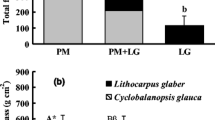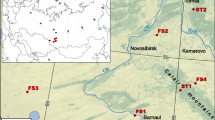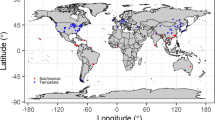Abstract
Fine root systems and mycorrhizal associations were examined in the central Amazonian várzea and igapó floodplain forests. While the várzea forest is located on fertile soil, infertile soil conditions prevail in the igapó region. Quantitative root analyses comprised of fine root length density within 8.5 cm soil depth (as a measure of root concentration) and fine root production rate within 43 cm soil depth. Fine root branching patterns and root symbioses with arbuscular/ endomycorrhiza (AM) or ectomycorrhiza (EM) were determined qualitatively. Fine root systems showed marked differences between the forest types. Fine root length densities, for both living and dead roots, were higher in the igapó as compared to the várzea. In spite of the greater fine root concentration within the topsoil, the fine root production rate was lower in the igapó relative to the várzea. It therefore appears that root longevity was greater and dead root decomposition lower in the igapó than in the várzea. While the majority of fine roots were concentrated within the surface horizon of the igapó, they extended to greater soil depth (43 cm) in the várzea. Root branching was characterised by higher ‘numbers of short roots’ in the igapó, while the ‘relative total root lengths’ were much higher in the várzea. In general, igapó roots were better equipped to retain nutrients within the soil-plant ecosystem through greater root concentration, greater root longevity and more intensive branching. Both forests associated predominantly with AM. EM symbiosis was only detected on Aldina latifolia in the igapó. The proposal by Singer and Araujo (1986) that the igapó forest should be viewed as an ectotrophic forest could not be confirmed by this study, as most of the tree species were symbiotically associated with the AM-type in both forests.
Access this chapter
Tax calculation will be finalised at checkout
Purchases are for personal use only
Similar content being viewed by others
References
Alexander IJ (1989) Mycorrhizas in tropical forests. In: Proctor J (ed) Mineral nutrition in tropical forest and Savanna ecosystems. Blackwell Scientific, Oxford, pp 169–188
Alexander IJ, Höberg P (1986) Ectomycorrhizas of tropical angiospermous trees. New Phytol 102:541–549
Anderson JM, Swift MJ (1983) Decomposition in tropical forests. In: Sutton SL, Whitemore TC, Chadwick AC (eds) Tropical rain forest: ecology and management. Blackwell Scientific, Oxford, pp 287–309
Babel U (1971) Gliederung und Beschreibung des Humusprofils in mitteleuropäischen Wäldern. Geoderma 5:297–324
Babel U (1979) Erfassung von Humusprofilmerkmalen mit Hilfe von Anschliffen. Zeitschr Pflanzenernährung Bodenkunde 142:195–205
Blair BC, Perfecto I (2001) Nutrient content and substrate effect on fine root density and size distribution in a Nicaraguan rain forest. Biotropica 33(4):697–701
Chapin FSIII, van Cleve K (1981) Plant nutrition adsorption and retention under differing fire regimes. In: Fire regimes and ecosystem properties. United States Forest Service Technical Report WO 26, pp 301–321
Cromack K, Sollins P, Graunstein WC, Speidel K, Todd WA, Spycher G, Y-Li C, Todd RL (1979) Calcium oxalate accumulation and soil weathering in mats of the hypogeous fungus Hysterangium crassum. Soil Biol Biochem 11:463–468
da Silvia GA, dos Santos BA, Alves MV, Maia LC (2001) Arbuscular mycorrhiza in species of Commelinidae (Liliopsida) in the State of Pernambuco (Brazil). Acta bot bras 15(2):155–165
Fischer WR, Flessa H, Schaller G (1989) pH values and redox potential in microsites of the rhizosphere. Zeitschrift Pflanzenernährung Bodenkunde 152:191–195
Fittkau EJ (1982) Struktur, Funktion und Diversität zentralamazonischer Ökosysteme. Arch Hydrobiol 95(1/4):29–45
Furch K (1997) Chemistry of várzea and igapó soils and nutrient inventory of their floodplain forests. In: Junk WJ (ed) The Central Amazon floodplain: ecology of a pulsing system. Ecolog Stud 126:47–68. Springer, Berlin/Heidelberg/New York
Furch K (2000) Chemistry and bioelement inventory of contrasting Amazonian forest soils. In: Junk WJ, Ohly JJ, Piedade MTF, Soares MGM (eds) The Central Amazon floodplain: actual use and options for a sustainable management. Backhuys, Leiden, pp 109–128
Furch K, Junk WJ (1997a) Physicochemical conditions in floodplains. In: Junk WJ (ed) The Central Amazon floodplain: ecology of a pulsing system. Ecolog Stud 126:69–108. Springer, Berlin/Heidelberg/New York
Gardner WK, Barber DA, Parbery DG (1983a) The acquisition of phosphorus by Lupinus albus L. III. The probable mechanism by which phosphorus movement in the soil/root interface is enhanced. Plant Soil 70:107–114
Gardner WK, Barber DA, Parbery DG (1983b) The acquisition of phosphorus by Lupinus albus L V. The diffusion of exudates away from roots: a computer simulation. Plant Soil 72:13–29
Haase K, Rätsch G (this volume) The morphology and anatomy of tree roots and their aeration strategies. In: Junk WJ, Piedade MTF, Wittmann F, Schöngart J, Parolin P (eds) Central Amazonian floodplain forests: ecophysiology, biodiversity and sustainable management. Springer, Berlin/Heidelberg/New York
Hansen A-C, Steen E (1984) Methods of calculating root production and nitrogen uptake in an annual crop. Swed J Agr Res 14:191–200
Högberg P, Piearce GP (1986) Mycorrhizas in Zambian trees in relation to host taxonomy, vegetation communities and successional patterns. J Ecol 74:775–785
Irion G, Adis J, Junk W, Wunderlich F (1984) Sedimentaufbau einer Amazonas-Insel. Natur und Museum 114(1):1–13
Jackson RM, Mason PA (1984) Mycorrhiza. The institute of biology’s studies in biology, p 59. E Arnold Publications, London
Janos DP (1983) Tropical mycorrhizas, nutrient cycles and plant growth. In: Sutton SL, Whitemore TC, Chadwick AC (eds) Tropical rain forest: ecology and management. Blackwell Scientific, Oxford, pp 327–345
Junk WJ, Barley PB, Sparks RE (1989) The flood-pulse concept in river-floodplain systems. Can Spec Publ Fish Aquat Sci 106:110–127
Junk WJ, Furch K (1985) The physical and chemical properties of Amazonian waters and their relationship with the biota. In: Prance GT, Lovejoy T (eds) Amazonia: key environments. Pergamon Press, Oxford, pp 3–17
Junk WJ, Piedade MTF (this volume) An introduction to SouthAmerican wetland forests: distribution, definitions and general characterization. In: Junk WJ, Piedade MTF, Wittmann F, Schöngart J, Parolin P (eds) Central Amazonian floodplain forests: ecophysiology, biodiversity and sustainable management. Springer, Berlin/Heidelberg/New York
Klinge H, Ohle W (1964) Chemical properties of rivers in the Amazonian area in relation to soil conditions. Verh Int Ver Limn XV:1067–1076
Kottke I (1986) Wurzelentwicklung und Wachstum der Fichte (Picea abies L.H. Karsten) auf unterschiedlichen Böden und künstlichen Substraten. In: Einsele G (ed) Das landschaftsökologische Forschungsprojekt Naturpark Schönbuch. Wasser- und Stoffhaushalt, Bio- Geo- und Forstwirtschaftliche Studien in Südwestdeutschland, VCH, Weinheim, pp 443–462
Laclau JP, Toutain F, M’Bou AT, Arnoud M, Joffre R, Ranger J (2004) The function of the superficial root mat in the biochemical cycles of nutrients in Congolese Eucalyptus plantations. Ann Bot 93:249–261
Malloch DW, Pirozynski KA, Raven PH (1980) Ecological and evolutionary significance of mycorrhizal symbiosis in vascular plants (a review). Proc Nat Acad Sci USA 77:2113–2118
Meyer FH (1967) Feinwurzelverteilung bei Waldbäumen in Abhängigkeit vom Substrat. Forstarchiv 38:286–290
Meyer U (1991) Feinwurzelsysteme und Mykorrhizatypen als Anpassungsmechanismen in zentralamazonischen Überschwemmungswäldern- Igapó and Várzea. Ph.D. thesis, University of Hohenheim, Germany
Moyersoen B, Becker P, Alexander IJ (2001) Are ectomycorrhizas more abundant than arbuscular mycorrhizas in tropical heath forests? New Phytol 150:591–599
Nadelhoffer KJ, Aber JD, Melillo JM (1985) Fine roots, net primary production, and soil nitrogen availability: a new hypothesis. Ecology 66(4):1377–1390
Parolin P, Wittmann F, Schöngart J (this volume c) Tree phenology in Amazonian floodplain forests. In: Junk WJ, Piedade MTF, Wittmann F, Schöngart J, Parolin P (eds) Central Amazonian floodplain forests: ecophysiology, biodiversity and sustainable management. Springer, Berlin/Heidelberg/New York
Paz H (2003) Root/shoot allocation and root architecture in Seedlings: variation among forest sites, microhabitats and ecological groups. Biotropica 35(3):318–332
Phillips LM, Hayman DS (1970) Improved procedures for clearing roots and staining parasitic and VA-Mycorrhiza fungi for rapid assessment of infection. Trans Br Mycol Soc 55:158–160
Priess J, Then C, Fölster H (1999) Litter and fine root production in three types of tropical premontane rain forest in SE Venezuela. Plant Ecol 143:171–187
Redhead JF (1980) Mycorrhiza in natural tropical forests. In: Mikola P (ed) Tropical Mycorrhiza research. Clarendon Press, Oxford, pp 127–142
Sayer EJ, Tanner EVJ, Cheesman AW (2006) Increased litterfall changes fine root distribution in a moist tropical forest. Plant Soil 281:5–13
Scherfose V (1990) Feinwurzelverteilung und Mykorrhizatypen von Pinus sylvestris in verschiedenen Bodentypen. Berichte des Forschungszentrums Waldökosysteme Göttingen, Reihe A, Bd 62, p 166
Schlichting E, Blume H-P, Stahr K (1995) Bodenkundliches Praktikum, 2nd edn. Blackwell Wissenschaftsverlag, Berlin
Schlüter U-B (1989) Morphologische, anatomische und physiologische Untersuchungen zur Überflutungstoleranz zweier charakteristischer Baumarten (Astrocaryum jauari und Macrolobium acaciaefolium) des Weiss- und Schwarz-wasserüberschwemmungswaldes bei Manaus.- ein Beitrag zur Ökosystemanalyse von Várzea und Igapó Zentralamazoniens. Ph.D. Thesis, University of Kiel, Germany
Singer R, Araujo I (1986) Litter decomposition and ectomycorrhizal Basidiomycetes in an igapó Forest. Pl Syst Evol 153:107–117
Szaniszlo PJ, Powell PE, Reid CPP, Cline GR (1981) Production of hydroxymate siderophore iron chelators by ectomycorrhizal fungi. Mycologica 73:1158–1178
Trappe JM, Fogel R (1977) Ecosystematic functions of mykorrhizae. In: Marschall JM (ed) The belowground ecosystem: a synthesis of plant-ssociated processes. Range Science Department Science Ser 26, Colorado State University, Fort Collins, Colorado, USA, pp 205–214
Vitousek PM (1982) Nutrient cycling and nutrient use efficiency. Am Nat 119:553–572
Vogt KA, Grier CC, Gower ST, Sprugel DG, Vogt DJ (1986) Overestimation of net root production: a real or imaginary problem? Ecol 67(2):577–579
Weibel EW (1979) Stereological methods, vol 1: practical methods for biological morphometry, p 415. Academic Press, New York
Acknowledgments
The author (Dr. U. Meyer) is grateful to Prof. Dr. Ulrich Babel of the Universität Hohenheim for the supervision of this study. This study was funded by the Deutsche Forschungsgemeinschaft, the Max-Plank Institute of Limnology and the Instituto Nacional de Pesquisas da Amazonia (INPA, Manaus). The plant species composition was determined by Mr. J. Revilla and L. Coehlo.
Author information
Authors and Affiliations
Corresponding author
Editor information
Editors and Affiliations
Rights and permissions
Copyright information
© 2010 Springer Science+Business Media B.V.
About this chapter
Cite this chapter
Meyer, U., Junk, W.J., Linck, C. (2010). Fine Root Systems and Mycorrhizal Associations in Two Central Amazonian Inundation Forests: Igapó and Várzea. In: Junk, W., Piedade, M., Wittmann, F., Schöngart, J., Parolin, P. (eds) Amazonian Floodplain Forests. Ecological Studies, vol 210. Springer, Dordrecht. https://doi.org/10.1007/978-90-481-8725-6_8
Download citation
DOI: https://doi.org/10.1007/978-90-481-8725-6_8
Published:
Publisher Name: Springer, Dordrecht
Print ISBN: 978-90-481-8724-9
Online ISBN: 978-90-481-8725-6
eBook Packages: Biomedical and Life SciencesBiomedical and Life Sciences (R0)




